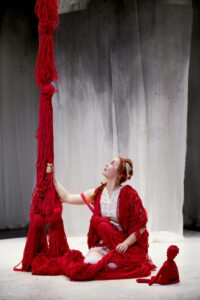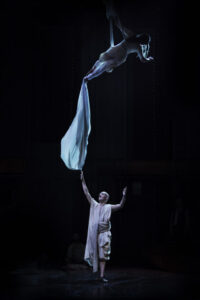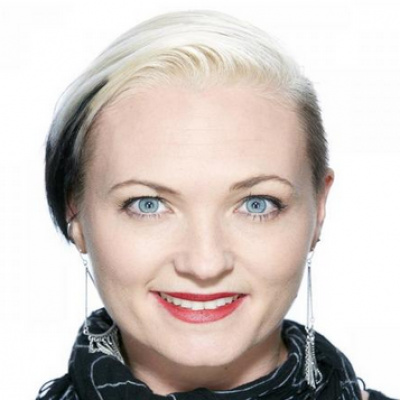Tilde Björfors: A Woman with A Circus Heart
The month of March has been a time set aside to recognize and honour the many contributions that women have made to our world, contributions that may have gone unsung in the past, overlooked simply because they were made by a woman. I came to the world of circus in my late twenties surrounded by wonderfully strong women, in body, mind, and spirit. There were few, if any men, in the contemporary circus sphere that I inhabited. In my naivety, I assumed that this was the way it was. I was unaware of the work that women before me had put into developing a vibrant and enduring contemporary circus scene around the world. Recently, I had the opportunity to sit down with Tilde Björfors, founder and former Artistic Director of Cirkus Cirkör, who after almost 30 years has retired from the company. During our conversation, we had the opportunity to look back on a long career and look forward to what’s next for this groundbreaking woman in the contemporary circus world.
Looking Back at What Was
As a young woman, Tilde felt like she could do whatever she wanted. “For me it’s quite strange because for my first 15 years with Cirkör I was never feeling like I couldn’t go directly to those with the power and I was never afraid of doing that,” she says. Yet, just two generations earlier, her grandmother didn’t have those same freedoms. “I feel very grateful for those that came before me. I don’t know if it was that I was lucky or if I was just so focused on my passion that I didn’t know or couldn’t see how the patriarchy worked, but now I see it everywhere,” she says.

The year is 1995 and 24 year-old Tilde was about to embark on a fabulous journey into the world of contemporary circus. “I was at the time an actress in Sweden and then in France. I got to know the contemporary circus and I was totally sold. It was like I had found something I had dreamt about my entire life without knowing that it existed,” Tilde reminisced. After discovering contemporary circus, she would travel back and forth between her native Sweden and France many times to train and began organising some circus training in Sweden, melding circus training with singing and music. “That’s what we started with – circus and singing,” she says. In fact, this is also where the name of the company evolved;kor meaning choir in Swedish.

“From an inside perspective, I just had to do it. It went very quickly too. It felt like Sweden had waited for the contemporary circus to develop in the country. Someone had to do it and it happened to be me,” she says.
“It was hard work. I worked like 24 hours a day. Well, 18 hour days every day for 10 years. I think I counted and had like 3 days free in that time,” she remembers. “It was my passion and was a dream. I was only 24 when I started, so I didn’t have so much to risk. I had nothing. The only thing I was risking was my acting career. I found when there was conflict I was always choosing Cirkör. Very early I had the vision that I wanted this artform to establish on so many levels.”
Tilde made the decision to quit her job as an actress and focus full-time on developing her vision of contemporary circus in Sweden. She began working on Cirkus Cirkör’s first show right away. “We didn’t know anything about how to tour. We said yes to everything,” she says. “The show was very unique and groundbreaking. When we came to a city close to one we had played earlier we would sell out the show, so the tour was a sold out tour.” Quite a feat for any new company staging its first ever production.
Shortly after, Cirkör was invited to Germany to a circus festival. One of their greatest breaks was when Circus Oz attended one of their shows and fell in love with the company. “Maybe we were like them when they were a young company,” says Tilde. Whatever the reason, they told their audiences to come see Cirkör’s show. “That’s when we started to know and understand the strengths of the international contemporary circus family and community. This is what I want to give back to others because we had so much support from a country that was beyond us.”
In 1997, Cirkus Cirkör established its first professional program for students to study circus after high school. “I wondered how my life would have been had I been training circus from a young age. That was a driving force to make the possibility for everyone to train circus in Sweden a choice because for me it made everything possible,” she says. “The students now come to schools that have existed for many years. They were not born when Cirkör was formed. In one way I am very happy because this was what the dream was because the artform should be established as a known artform and you as a circus artist should have the same opportunities as someone who wants to be a dancer or anything else,” she says.
What Is and What’s to Come

“I have been longing for something,” she says. “I have never wanted power … I have wanted the power to make things happen. I still have the connections and the network and it looks like I have respect, in some places at least,” she laughs, “so I can make things happen, and maybe more happen, from this place.”
When thinking about her departure from one of the largest and most respected circus companies in the world, Tilde says, “One part of me misses something of the pioneering because for me that’s also something that is part of the circus heart that I fell in love with. You do the impossible.” She continues with, “One of the reasons I have to go is because I want to work in places with others that want to do what they’re doing to create art and change lives for people and for us. And I think I can do it better and have more possibilities for that outside of Cirkör.”
Tilde has spent time outside of Sweden working with burgeoning circus companies such as Cirk La Putyka, located in the Czech Republic. “It is happening there. They have a big community there now… as big as Cirkör, but 15 years younger and they really still have the pioneering… That’s a place where I really like to be and my experience can be useful,” she says.
In the south of Sweden there is also the pioneering feeling that Tilde speaks of throughout our discussion. “That’s a place where I feel my strength and my heart can bloom in another way. I feel I can be more of service to the art. I have much experience after all these years and … I want to do what’s best for the artform. Where can my strengths and experience be used in the best way?” she asks of herself. “I am diagnosed with a circus heart. One of the things in a circus heart is that it is entrepreneurial and going where we haven’t been going before and to make risk become possibilities and make the impossible possible. Because I am diagnosed with a circus heart I have to do this. To be happy I have to be where you can feel it is happening.”
The fact that contemporary circus is an international artform, one that lives on every continent means that Tilde can findit in many places around the world and work with those who also have the “circus heart” beating within their chests. But, the world looks very different now than it did 30 years ago. “When we started everyone was new. You had to create. If you wanted to go to circus school you had to make a circus school. If you wanted a circus company you had to make a circus company. You had to educate the audience and theatres if you wanted to perform in the theatre,” she says.
After 30 years in the contemporary circus world, Tilde has seen and lived through many different cycles and loops. Trends come and they go. Politics give and they take. Companies rise and fall. “I think the whole world, we are in a very rough period and this is also for the arts and for artists. And I can feel it,” she says. “And what I hope and I feel is that in the circus our history of creativity and entrepreneurship and making something from nothing and I hope we can use this talent to stay and help each other through this period. And I think it’s more important now than ever. And on the other side of this maybe something can happen,” she says.

“The circus can become a catalyst or springboard for change,” Tilde says. “How can we use our training from the circus – trust, collaboration, how to handle risk, fears and failures and all of this training?” she asks. “You can adapt and use it when you are building and establishing a school or company or making change on a societal level! Artists have the best skills to handle this, but we need to support each other and help each other. If we succeed I feel the circus will bloom.”
Shows directed by Tilde during her tenure with Circus Cirkör:
Circus direction, Romeo & Julia (2002)
Direction, 99% Unknown (2004)
Circus direction, Havfruen (2005)
Circus direction, Momo (2006)
Direction, Inside Out (2008)
Direction, Wear it like a Crown (2010)
Direction, Knitting Peace (2013)
Direction, Borders (2015)
Direction, Limits (2016)
Direction, Satyagraha (2016)
Direction, Movements (2017)
Direction, Epifónima (2018)
Direction, God’s Disobedient Rib (2019)
Direction & libretto, Circus Days and Nights (2021)
Circus direction, Pippi at the Circus (2022)
Do you have a story to share? Submit your news story, article or press release.





